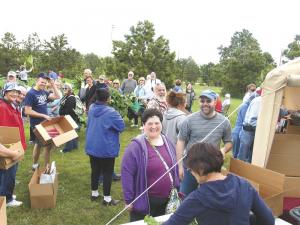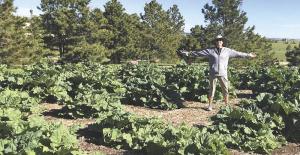2019 - Volume #43, Issue #5, Page #07
[ Sample Stories From This Issue | List of All Stories In This Issue | Print this story
| Read this issue]
U-Pick Rhubarb Draws Crowd
 |
 |
He and his wife, Donna, tapped into a market of rhubarb-loving consumers in Colorado and elsewhere who are willing to pay $3.75/lb. to pick rhubarb themselves during a one-time harvest on a weekend in early June.
“We get 400 or 500 people and have a crew of a dozen volunteers,” Duncan says. “It’s a big party. Families come out with kids and pets.”
Customers pick the stalks, take them to a tent where Duncan’s crew removes the leaves, and then to another tent to have them weighed. Average sales are about 10 lbs./customer, in addition to a couple of commercial pickers who pick 200 to 500 lbs. of rhubarb.
Currently, with about 400 plants on half an acre, High Altitude Rhubarb produces about 3,000 lbs. of rhubarb a season. With new plants that will be in production in 4 years, Duncan expects to produce 7,000 to 9,000 lbs.
He got started when a friend gave him some rhubarb roots. His plants only yielded a few stalks so Duncan researched and figured out how to create a nurturing environment for plants to grow 4 ft. tall and 8 ft. wide.
He creates good loam with mulch and compost, then builds 3-ft. high mounds of top soil about 10 ft. apart. He fills the spaces between the mounds with pine mulch to prevent weeds and makes water rings at the top of the mounds around the plants. It recently cost $3,000 to establish a new plot for 60 plants. The mulch composts in place, yielding soil similar to the native soils but deeper.
“We deep water about five times a year,” Duncan says, noting that the mounds compress as the mulch composts and he tops the mulch off every 5 years.
His oldest beds are 20 years old and rhubarb plants typically produce for about 25 years. Through the years he’s added 20 varieties. Some consumers prefer the red varieties, but the most prolific variety is Victoria. It’s a greener rhubarb, but tastes the best, has thin skin and the best yield.
Duncan notes that there is typically only one harvest, because in mid-June the area is usually hit with large hail storms. Then comes the extreme heat. In some years there is enough regrowth that he takes reservations for a second harvest in July.
The Duncans figure they spend a couple of months a year on their “hobby farm” - working with the plants, website updates, organic certification paperwork, and bookwork.
Duncan started with hand tools and has since mechanized with a 25 hp. John Deere tractor and attachments to do 95 percent of the field work. His background in the corporate world of computers has been useful for marketing; his website gets 30,000 hits a year. Combined with word of mouth and articles written about the business, the Duncans don’t need to advertise.
In fact, Duncan says, his biggest risk is running out of rhubarb.
“We are a destination business, and we don’t want people to drive here for nothing,” he says, noting he knows of one customer who drove 13 hours to pick their rhubarb.
Duncan shares his technique for growing rhubarb on his website. He has advice for anyone who wants to create a destination business. “Differentiate yourself. Focus on something unique in your area,” he says.
Contact: FARM SHOW Followup, Dennis and Donna Duncan, High Altitude Rhubarb, 7275 Wildridge Rd., Black Forest, Colo. 80908 (ph 719 494-8424; www.highaltituderhubarb.com; dennis.duncan@highaltituderhubarb.com).

Click here to download page story appeared in.

Click here to read entire issue
To read the rest of this story, download this issue below or click here to register with your account number.




